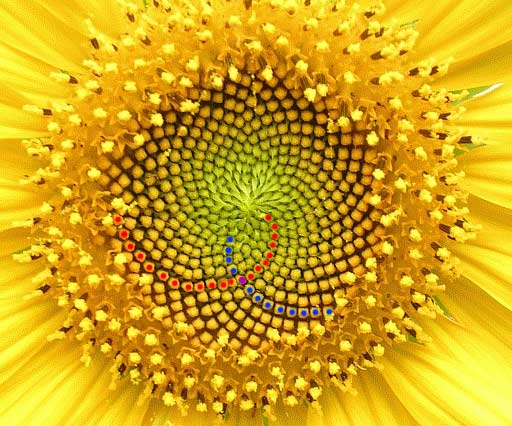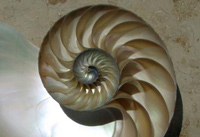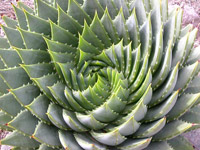Fibonacci FractalsThe Spiralizer
We're going to explore what happens when we change the angle that generates the spiral. Play with the Angle slider in the Spiralizer applet below: This Spiralizer generates dots at a given angle. The distance of each point from the center keeps increasing at the same rate. Adjust the angle with the slider, or use the arrow keys to amke small adjustments. Applet courtesy of Andrei Buium. At very low angles, the applet creates a simple spiral. But as you increase the angle, all sorts of interesting patterns emerge. It can become difficult to determine the order of the dots. Click on "Connect Dots" to make the connections easier to see. If you set the angle to 180 degrees, the point will rotate to the other side, and then back again at the next iteration, and so on, oscillating with a period of 2. If you set the angle to be 90 degrees, The dots will grow in a square pattern, that is, with a period of 4. The periodicity can be determined by dividing the angle of a full circle, 360 degrees, by the rotation angle. For example, 360 / 90 = 4. The progression of the points is just 0, 90, 180, 270 degrees. Then it returns to 360, which is the same as 0 degrees, and the pattern begins again. There is another angle that will generate period-4 patterns: 270 degrees. This is 360 degrees - 90 degrees. We can see why this works by examining the progression of the angles. Start with iteration 0 at at 0 degrees. The first iteration takes the point 3/4 of the way around the circle or 270 degrees. Then the second iteration adds 270 degrees, which is 540 degrees. This is the same as 360 + 180, so it's halfway around the circle. The next iteration takes the point to 810 degrees, which is the same angle as 720 + 90, or 2 and 1/4 times around the circle. In general, the periodicity P = 360 / A, where is the angle around the circle. If we want to find a specific periodicity, we can rearrange the equation to solve for A = 360 / P.
One interesting thing to observe is that when the angle is set exactly to a value that repeats perfectly, such as 90 degrees, the points line up in straight lines.
But if you adjust the angle just a tiny bit larger or smaller than one of these perfect values, then the dots start to twist into spirals. You can nudge the angle 0.1 degrees
at a time with the arrow keys to see the effect of perturbing the angle just slightly.
There are many other higher-order periodicities that emerge in between the simple angles that create triangles, square, pentagons and hexagons, and we will explore
the more complex details in the next section, when we relate this behavior to the periodicities of the Mandelbrot Set.
Fibonacci PackingThe Fibonacci Sequence appears in many plants, and can be seen in the distribution of the seeds in the sunflower below. Image courtesy of L. Shyamal and Jonathan Wolfe. A sunflower pattern can be created by a simple repetitive process similar to how the spiralizer forms its patterns. Imagine the flower operating like the Spiralizer. It creates a seed at the origin, and then it rotates by a certain angle and creates another seed. Then it rotates again by the same angle and forms a third seed. It keeps rotating by the same angle and adding seeds, which all keep growing in scale and distance from the center. How does the angle affect the outcome of the pattern of seeds? As we saw with the spiralizer, when you set the angle to be a simple fraction of the whole way around the circle, the dots (or seeds) line up in radial arms. This is a simple pattern, but it is NOT the most efficient way to pack a lot of seeds into a given area. You can see the percentage of space filled by dots at the bottom of the Spiralizer. For instance, when the angle of rotation is 90 degrees, the dots fall in a period-4 pattern, and the percentage of the space filled by dots is 11.436%. This is a relatively small proportion, and is a poor use of space. When the angle of rotation is not simple like 1/2, 1/3, or 1/4, but instead is an irrational fraction of the circle, then the angle never quite repeats itself, and much more complex patterns are possible. Sometimes these arrangements alloiw a much more efficient packing of seeds into a given area. When the angle of rotation is set to be the 360/φ that is, the fraction of the circle correspinding to the Golden Ratio, then the seeds pack in the most efficient way possible. Try it with the Spiralizer above! What is the "Golden Angle" for this optimal packing? 360 / 1.61803399 is approximately equal to 222.5 degrees. Set the angle in the Spiralizer to 222.5 (you might need to use the arrow keys to set it precisely), turn the drawing speed down about half way, and click "Connect Dots" to illustrate how a sunflower arranges its seeds. One amazing thing to observe is that in systems that use this packing system (many flowers, pinecones, strawberries, pineapples, artichokes, etc)
you can often find the Fibonacci Sequence. This is illustrated in the picture of the sunflower above. The pattern forms intersecting spirals where the number of
seeds in the counter-clockwise spiral is part of the Fibonacci Sequence, and the number of seeds in the clockwise spiral is the next highest Fibonacci Number. This is often difficult to count,
and sometimes it is not exactly correct, but in general the ratio of the seeds counted in one direction to the number of seeds in the other direction is close to the
Golden Ratio φ.
|
||
|
<- PREVIOUS NEXT -> © Fractal Foundation. |

